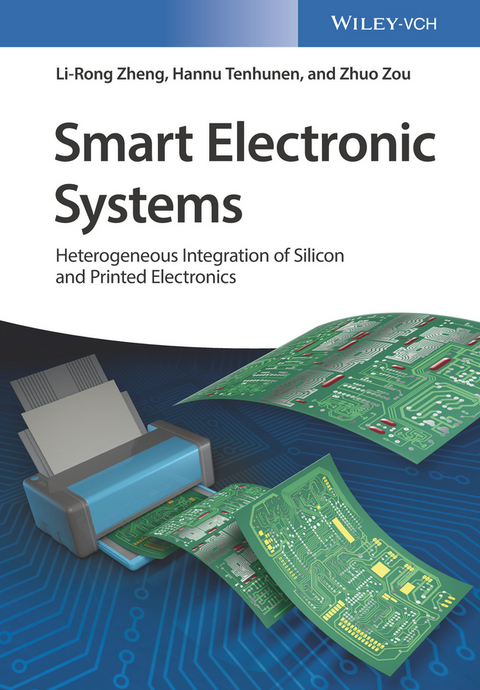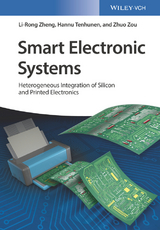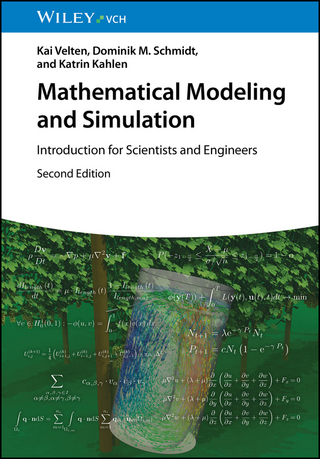Smart Electronic Systems
Wiley-VCH (Verlag)
978-3-527-33895-5 (ISBN)
Li-Rong Zheng is professor in Media Electronics at the Swedish Royal Institute of Technology (KTH) in Stockholm, Sweden, as well as founder and director of iPack VINN Excellence Center. Since 2010, he holds the position as a distinguished professor and director of ICT School at the Fudan University in Shanghai, China. His research interests include electronic circuits, wireless sensors, systems for ambient intelligence and the internet-of-things. In 2001, he received his Ph.D. degree in electronic system design from the Swedish Royal Institute of Technology (KTH) in Stockholm, Sweden. He has authored more than 400 scientific publications. He is member of the steering board of the International Conference on Internet-of-Things. Hannu Tenhunen is professor at the Swedish Royal Institute of Technology (KTH) in Stockholm, Sweden, and holds invited and honorary professorships in Finland, USA, France, China and Hong Kong. During the last 20 years he has been actively involved in high technology policies, technology impact studies, innovations and changing the educational system. For instance, he was director of various European graduate schools and he was Education Director of the new European flagship initiative European Institute of Technology and Innovations (EIT) and the Knowledge and Innovation Community: EIT ICT Labs. He has authored more than 700 scientific publications and holds 9 patents. Furthermore, he was one of the originators of the interconnect-centric design, globally asynchronous/locally synchronous concept and network-on-chip (NoC) paradigms.
INTRODUCTION
Definition of Printed Electronic Systems
Technology, Applications and Markets
Challenges and Future Trends
References
PART 1: MATERIALS AND PROCESSES FOR PRINTED ELECTRONICS.
FUNCTIONAL ELECTRONIC INKS
Introduction
Conductive Inks
Semiconducting Inks
Summary
FLEXIBLE SUBSTRATES AND FOR PRINTED INTERCONNECTIONS
Introduction
Polyimide versus Paper Sheets
Paper Surface Properties and Printed Interconnections
Reliability Assessment of Paper Based Printed Interconnections
Summary
PART 2: PRINTED ELECTRONIC BUILDING BLOCKS.
PRINTED THIN FILM TRANSISTORS (TFTS) AND CIRCUITS
Introduction
Printing Process of TFTs
Electrical Performance of the TFTs
Carbon Nanotube TFTs and Circuits
Summary and Outlook
PRINTED PASSIVE WIRELESS SENSORS
Introduction
Sensing Materials
Time Domain Based Sensors
Frequency Domain Based Sensors
Conclusion and Future Work
PRINTED RFID ANTENNAS
Background
Trends and Challenges
Narrow Band RFID Antennas
Wideband RFID Antennas
Sensor-enabled Antennas
Conclusions and Future Work
PRINTED CHIPLESS RFID TAGS
Introduction
Applications and Market Projection
Time Domain Chip-less RFID Tags
Frequency Domain Based Chip-less RFID tags
Summary and Future Work
PART 3. SYSTEM INTEGRATION FOR PRINTED ELECTRONICS.
FLEXIBLE BIO-PATCH
Background
Integration Methodology
Paper-based Bio-patch
Polyimide-based Bio-patch
Summary and Future Work
HUMIDITY SENSOR CARDS
Introduction
System Overview
Integration Methodology
Demonstrations of Humidity Sensor Cards on Plastic and Paper
Bendability of the Cards
Conclusion
SUMMARY AND OUTLOOK
| Erscheinungsdatum | 07.11.2018 |
|---|---|
| Verlagsort | Berlin |
| Sprache | englisch |
| Maße | 170 x 244 mm |
| Gewicht | 714 g |
| Themenwelt | Naturwissenschaften ► Chemie |
| Technik ► Elektrotechnik / Energietechnik | |
| Technik ► Maschinenbau | |
| Schlagworte | Components & Devices • Components & Devices • Dünne Schichten, Oberflächen u. Grenzflächen • Electrical & Electronics Engineering • Electrical & Electronics Engineering • Elektronik • Elektrotechnik u. Elektronik • Industrial Engineering • Industrial Engineering / Manufacturing • Industrielle Verfahrenstechnik • Komponenten u. Bauelemente • Materials Science • Materialwissenschaften • Produktion i. d. Industriellen Verfahrenstechnik • Thin Films, Surfaces & Interfaces • Thin Films, Surfaces & Interfaces • Verfahrenstechnik |
| ISBN-10 | 3-527-33895-0 / 3527338950 |
| ISBN-13 | 978-3-527-33895-5 / 9783527338955 |
| Zustand | Neuware |
| Informationen gemäß Produktsicherheitsverordnung (GPSR) | |
| Haben Sie eine Frage zum Produkt? |
aus dem Bereich




